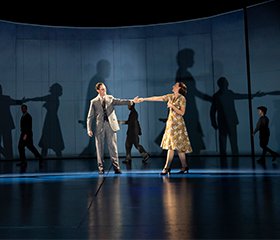“There’s an old adage in the theater,” Bradley King told me the other day. “’No one ever leaves humming the scenery.’” But King, the imaginative lighting designer for Flying Over Sunset, hadn’t heard what I heard as audiences streamed out of the Vivian Beaumont Theater after a recent performance. Among the show’s elements singled out for high praise were, in fact, the visuals, including the lighting.
Of course, what King, insightful on the subject of stage design, implied was that you don’t want theatergoers enjoying the visuals only. “My primary job,” King said, “is to support the storytelling provided by the creative team” – in the current instance, the composer Tom Kitt, the lyricist Michael Korie, and the book writer/director James Lapine.
The story being told concerns Aldous Huxley, Clare Boothe Luce, Cary Grant, and Gerald Heard and their taking LSD in the 1950s. King said that when he and other members of the creative team sat down with Lapine early in the musical’s gestation they decided to avoid the imagery many people associate with the drug: the tie-dye patterns of late-60s. More than historical chronology influenced this decision. “These people weren’t dropping acid at a rock concert,” King said. “They were doing it at a psychiatrist’s office or in a New England garden or around a Malibu swimming pool.”
Is King’s job to give us the show’s Connecticut or California lighting? “You can’t really reproduce specific natural light,” he explained, “and, in any case, there’s no point trying to compete with the greatest lighting ever made.” He added: “What we designers can do is to convey what light makes us feel. And to do that well it helps to have spent time in the places of the story.”
Traveling to the places of Flying Over Sunset was easier than visiting the Underworld, the location of Hadestown, or 19th-century Russia, the location of Natasha, Pierre & the Great Comet of 1812. For both these shows, in which King worked with his frequent collaborator, the director Rachel Chavkin, he won Tony Awards for Best Lighting Design in a Musical. (Their next show is the new musical Lempicka, about the 20th-century Polish painter Tamara Lempicka, revised from earlier incarnations and scheduled for the La Jolla Playhouse in June.)
“It’s easier to light a musical than a play,” King said. “Because you have the element of music to work with. That changes the ebb and flow of the lighting. But you have to be careful: you have to know when to support music and dance and when to get out of the way.”
When it came to Flying Over Sunset, in which songs are performed while characters are under the influence of LSD, did King feel the need to support or retreat? “I didn’t look at it that way,” he answered. “I was concerned not to replicate what it looks like to be tripping. And not just because I’ve never done LSD myself but because the effect of psychedelics is essentially introspective and individual. I can’t get inside a person’s head but, guided by the dialogue, music, and lyrics, I can, as I mentioned earlier, try to help convey what they might be feeling.” He added: “Watching the on-acid musical numbers is also very individual. I didn’t want the lighting to be so specific in meaning that it dictates what people should feel. They should bring their own associations to the experience.”
Brendan Lemon is the editor of lemonwade.com
